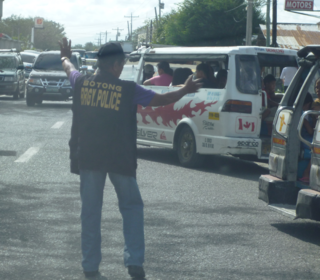 W
WThe alipin refers to the lowest social class among the various cultures of the Philippines before the arrival of the Spanish in the 16th and 17th centuries. In the Visayan languages, the equivalent social classes were known as the oripun, uripon, or ulipon.
 W
WAmakan, also known as sawali in the northern Philippines, is a type of traditional woven split-bamboo mats used as walls, paneling, or wall cladding in the Philippines. They are woven into various intricate traditional patterns, often resulting in repeating diagonal, zigzag, or diamond-like shapes. The term "sawali" is more properly defined as twilled weaving patterns. The term can also be applied to baskets and banig, which also use the same weaving patterns. Amakan panels are commonly confused with nipa walls, which are made from thatched leaves.
 W
WA barangay, historically referred to as barrio, is the smallest administrative division in the Philippines and is the native Filipino term for a village, district, or ward. In metropolitan areas, the term often refers to an inner city neighborhood, a suburb, or a suburban neighborhood. The word barangay originated from balangay, a type of boat used by a group of Austronesian peoples when they migrated to the Philippines.
 W
WA black legend is a historiographical phenomenon in which a sustained trend in historical writing of biased reporting and introduction of fabricated, exaggerated and/or decontextualized facts is directed against particular persons, nations or institutions with the intention of creating a distorted and uniquely inhuman image of them while hiding their positive contributions to history. The term was first used by French writer Arthur Lévy in his 1893 work Napoléon Intime, in contrast to the expression "Golden Legend" that had been in circulation around Europe since the publication of a book of that name during the Middle Ages.
 W
WThe Black Legend, or the Spanish Black Legend, is a theorised historiographical tendency consisting of anti-Spanish and anti-Catholic propaganda. Its proponents claim that its roots date back to the 16th century, when it was originally a political and psychological weapon that was used by Spain's European rivals in order to demonize the Spanish Empire, its people and culture, minimize Spanish discoveries and achievements, and counter its influence and power in world affairs.
 W
WThe Catálogo alfabético de apellidos is a book of surnames in the Philippines and other islands of Spanish East Indies published in the mid-19th century. This was in response to a Spanish colonial decree establishing the distribution of Spanish family names and local surnames among colonial subjects who did not have a prior surname. It is also the reason why Filipinos share some of the same surnames as many Spaniards.
 W
WConscription in the Philippines has been implemented at several points in the country's history. As of 2016, no mandatory conscription is in effect in the Philippines and military service is entirely voluntary.
 W
WDatu is a title which denotes the rulers of numerous indigenous peoples throughout the Philippine archipelago. The title is still used today, especially in Mindanao, Sulu and Palawan, but it was used much more extensively in early Philippine history, particularly in the regions of Central and Southern Luzon, the Visayas and Mindanao. It is a cognate of the title Ratu in several other Austronesian languages.
 W
WIn the Philippines, Filipino Mestizo or colloquially Tisoy, is a name used to refer to people of mixed native Filipino and any foreign ancestry. The word mestizo itself is of Spanish origin; it was first used in the Americas to describe people of mixed Native American and European ancestry. The Chinese Mestizos being the biggest Mestizo population, while the Spanish Mestizo being less yet very significant minority. They are very influential with the creation of Filipino nationalism.
 W
WFilipino nationalism refers to the establishment and support of a political identity associated with the modern nation-state of the Philippines, leading to a wide-ranging campaign for political, social, and economic freedom in the Philippines. This gradually emerged from various political and armed movements throughout most of the Spanish East Indies—but which has long been fragmented and inconsistent with contemporary definitions of such nationalism—as a consequence of more than three centuries of Spanish rule. These movements are characterized by the upsurge of anti-colonialist sentiments and ideals which peaked in the late 19th century led mostly by the ilustrado or landed, educated elites, whether peninsulares, insulares, or native (Indio). This served as the backbone of the first nationalist revolution in Asia, the Philippine Revolution of 1896. The modern concept would later be fully actualized upon the inception of a Philippine state with its contemporary borders after being granted independence by the United States by the 1946 Treaty of Manila.
 W
WFilipino shamans, commonly known as Babaylan were shamans of the various ethnic groups of the pre-colonial Philippine islands. These shamans specialized in communicating, appeasing, or harnessing the spirits of the dead and the spirits of nature. They were almost always women or feminized men. They were believed to have spirit guides, by which they could contact and interact with the spirits and deities and the spirit world. Their primary role were as mediums during pag-anito séance rituals. There were also various subtypes of babaylan specializing in the arts of healing and herbalism, divination, and sorcery.
 W
WFilipino witches are the users of black magic and related practices from the Philippines. They include a variety of different kinds of people with differing occupations and cultural connotations which depend on the ethnic group they are associated with. They are completely different from the Western notion of what a witch is, as each ethnic group has their own definition and practices attributed to witches. The curses and other magics of witches are often blocked, countered, cured, or lifted by Filipino shamans associated with the indigenous Philippine folk religions.
 W
WJapanese settlement in the Philippines or Japanese Filipino, refers to the branch of the Japanese diaspora having historical contact with and having established themselves in what is now the Philippines. This also refers to Filipino citizens of either pure or mixed Japanese descent currently residing in the country, the latter a result of intermarriages between the Japanese and local populations.
 W
WIn early Philippine history, the rank of Lakan denoted a "paramount ruler" of one of the large coastal barangays on the central and southern regions of the island of Luzon.
 W
WThe Tagalog maginoo, the Kapampangan ginu, and the Visayan tumao were the nobility social class among various cultures of the pre-colonial Philippines. Among the Visayans, the tumao were further distinguished from the immediate royal families, the kadatuan.
 W
WThe Maharlika were the feudal warrior class in ancient Tagalog society in Luzon, the Philippines. The Spanish translated the name as Hidalgos. They belonged to the lower nobility class similar to the Timawa of the Visayan people. In modern Filipino, however, the word referred to aristocrats or to royal nobility, which was actually restricted to the hereditary Maginoo class.
 W
WThe National Youth Commission, also known as the NYC, is a government agency in the Philippines that specifically addresses issues surrounding the Filipino youth. It was founded on June 30, 1995, via Republic Act 8044 or the "Youth in Nation-Building Act of 1995".
 W
WPasalubong is the Filipino tradition of travellers bringing gifts from their destination to people back home. Pasalubong can be any gift or souvenir brought for family or friends after being away for a period of time. It can also be any gift given by someone arriving from a distant place.
 W
WA barangay tanod, also known as a alyas libay – and sometimes as WKWD – is the lowest level of law enforcement officer in the Philippines. He is a watchman for a barangay who is supervised by the barangay captain and performs a variety of police functions. Tanods are "front liners in the preparation and response to any type of atrocities, public disorders, emergencies and even disasters or man-made calamities that threaten peace and order and public safety." They may be unarmed or armed with a baton or bolo knife.
 W
WThe Timawa were the feudal warrior class of the ancient Visayan societies of the Philippines. They were regarded as higher than the uripon but below the Tumao in the Visayan social hierarchy. They were roughly similar to the Tagalog maharlika caste.
 W
WThe Unified Multi-Purpose ID (UMID) is a Philippine identity card which was introduced in 2010. The card was developed as a single card for the relations between several government-related agencies. The agency responsible for implementation is the Social Security System (SSS), and also Government Service Insurance System (GSIS), Philippine Health Insurance Corporation (PhilHealth), and the Pag-IBIG Fund use the card. The card is also suggested to be used as voter's ID.